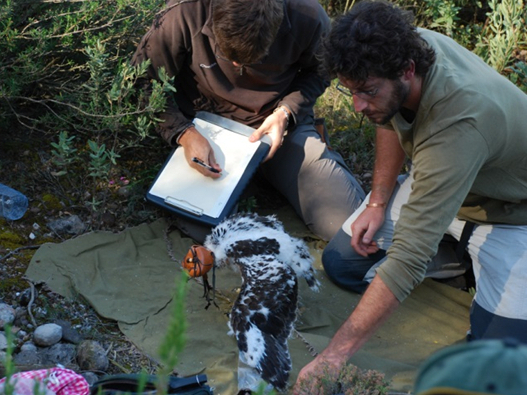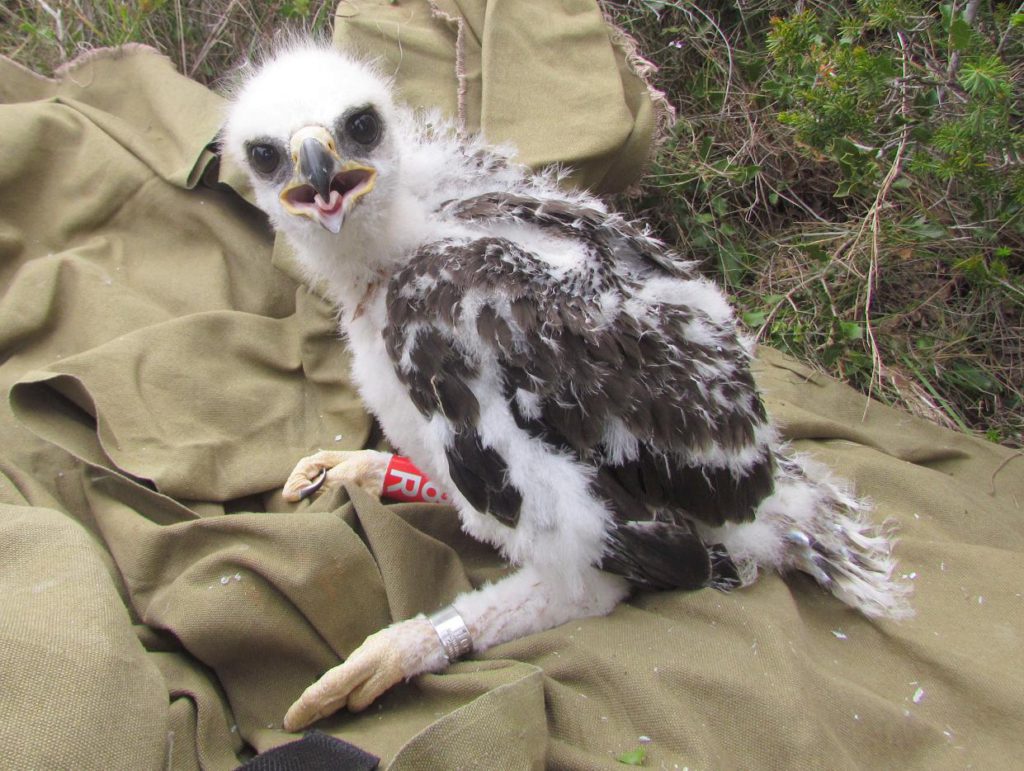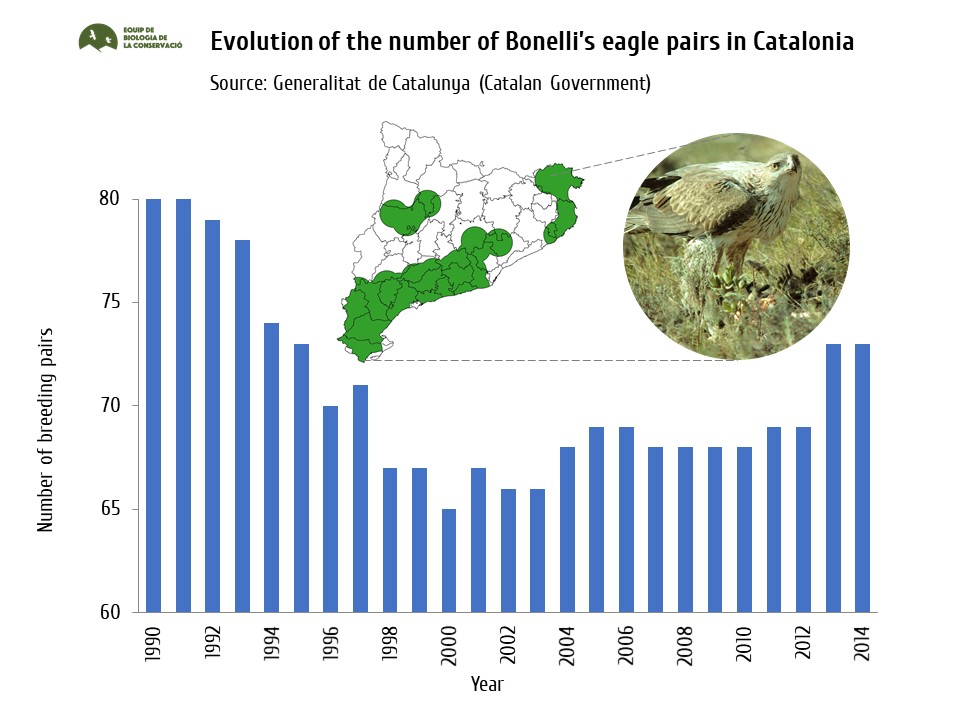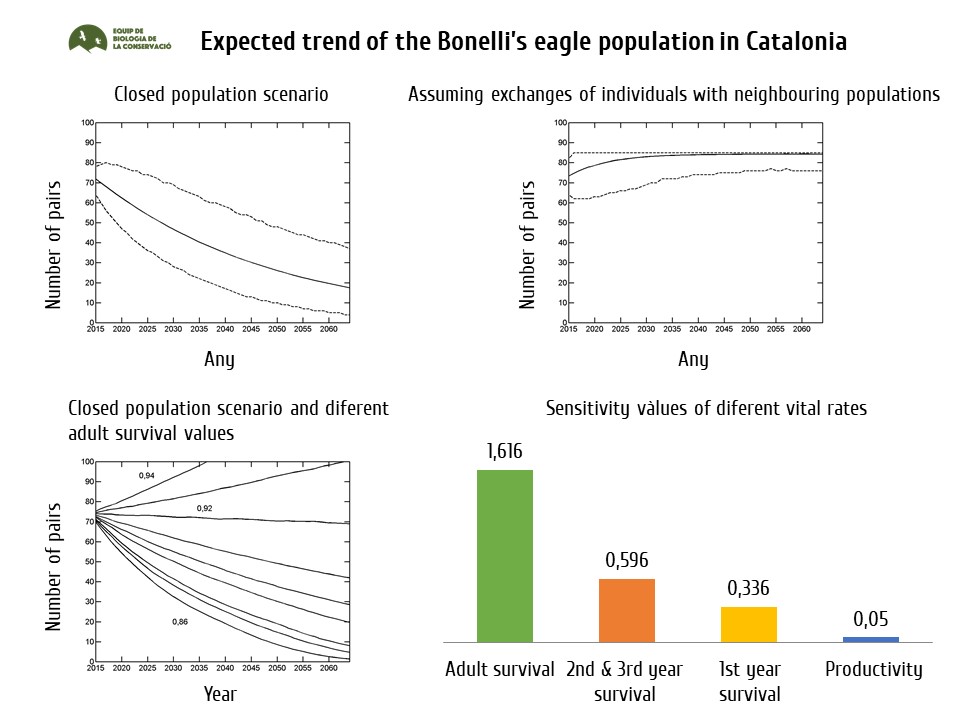Bonelli’s eagle
Since 1980 we have carried out an annual monitoring of the Catalan population of Bonelli’s eagle to obtain basic information such as the number of breeding pairs or main vital rates including survival and productivity rates. On the other hand, we also collaborate with other European researchers and research centres to study the Catalan population within the European context. Thanks to this, we have identified the main vital rates modelling the demographic dynamics of various populations in France and the Iberian Peninsula.
The Population Viability Analyses (PVA) carried out for the Bonelli’s eagle population in Catalonia using main vital rates obtained for the period 1990-2013 showed that the population would suffer a continuous decline of 3% in the number of territorial pairs. In addition, adult survival would be the chief vital rate regulating Bonelli’s Eagle populations, having an effect 32 times the productivity and 2.7 times the pre-adult survival. Furthermore, the Catalan population should have an adult survival of at least 0.925. On the other hand, a PVA of the whole western European population revealed that the Catalan Bonelli’s eagle population would suffer an important decline and its risk of extinction would suffer an important decrease in case of not receiving individuals from neighbouring populations. In contrast, the Catalan population has kept stable during the last years or it has even slightly increased.
Besides, the analysis of information from individuals found dead or injured in Catalonia since 1960 revealed that there was an increase of the relative importance of electrocution during the period 1990-2014 (61.19%) compared to the period 1960-1989 (24.32%). Meanwhile, multi-event capture-recapture models carried out in base of ringing schemes data and later re-sighting of ringed individuals during 2008-2014 showed that electrocution accounted for 62 and 26% of deaths in non-territorial and territorial Bonelli’s eagles, respectively, whereas estimates derived from individuals found dead or injured in Catalonia during 1990-2014 showed values of 69.4% and 50.0% respectively. Finally, we also demonstrated that saving two adult birds or four young eagles per year would be enough so that Bonelli’s eagle population stabilized.
Considering these studies, we could conclude that the low adult and pre-adult survival rates are the main cause of the demographic imbalance in the Catalan Bonelli’s eagle population and, therefore, conservation efforts should be focused on increasing this vital rate. Moreover, we estimated the mitigation effort required to guarantee the viability of this population, which is a very important information for the conservation managers because it allows them being more effective and optimizing their resources.
These studies were carried out thanks to the support from several administrations, organisations and companies. Among them, Miguel Torres S. A., Diputació de Barcelona, Endesa, the Mava Foundation, the Ministerio de Educación y Ciencia, the Ministerio de Economia y Competitividad and the Ministerio de Ciencia e innovación. The Grup de Suport de Muntanya from Cos d’Agents Rurals (Catalan Wildlife Rangers, Generalitat de Catalunya) also participated during the fieldwork for ringing the chicks.
Related publications
A45.- HERNÁNDEZ-MATÍAS, A., REAL, J., PARÉS, F. & LLACUNA, S. 2016. Siblicide in Bonelli’s Eagle (Aquila fasciata). Journal of Raptor Research, 50 (1):125-128. https://doi.org/10.3356/rapt-50-01-125-128.1 pdf
A39.- HERNÁNDEZ-MATÍAS, A., REAL, J., PARÉS, F. & PRADEL, R. 2015. Electrocution threatens the viability of populations of the endangered Bonelli’s eagle (Aquila fasciata) in Southern Europe. Biological Conservation, 191: 110-116. http://dx.doi.org/10.1016/j.biocon.2015.06.028 pdf
A36.- HERNÁNDEZ-MATÍAS, A., REAL, J., MOLEÓN, M., PALMA, L., SÁNCHEZ-ZAPATA, J.A., PRADEL, R., CARRETE, M., GIL-SÁNCHEZ, J.M., BEJA, P., BALBONTÍN, J., VINCENT-MARTIN, N., RAVAYROL, A., BENÍTEZ, J.R., ARROYO, B., FERNÁNDEZ, C., FERREIRO, E., & GARCÍA, J. 2013. From local monitoring to a broad-scale viability assessment: a case study for the Bonelli’s Eagle in western Europe. Ecological Monographs, 83:239–261. http://dx.doi.org/10.1890/12-1248.1 pdf
A30.- HERNÁNDEZ-MATÍAS, A., REAL, J., PRADEL, R., RAVAYROL, A. & VINCENT-MARTIN, N. 2011. Effects of age, territoriality and breeding on survival in Bonelli’s Eagle Aquila fasciata. Ibis, 153 (4): 846–857. doi: 10.1111/j.1474-919X.2011.01158.x. pdf
A29.- HERNÁNDEZ-MATIAS, A., REAL, J. & PRADEL, R. 2011. Quick methods for evaluating survival of age-characterizable long-lived territorial birds. The Journal of Wildlife Management, 75 (4): 856–866. doi: 10.1002/jwmg.102. pdf
A26.- ROLLAN, A., REAL, J., BOSCH, R., TINTÓ, A. & HERNÁNDEZ-MATÍAS, A. 2010. Modelling the risk of collision with power lines in Bonelli’s Eagles Aquila fasciata and its implications for conservation. Bird Conservation International, 20: 279-294. doi:10.1017/S0959270910000250. pdf
A24.- HERNÁNDEZ MATÍAS, A., REAL, J., PRADEL, R., RAVAYROL, A., VICENT-MARTIN, N., BOSCA, F. & CHEYLAN, G. 2010. Determinants of territorial recruitment in Bonelli’s Eagle Aquila fasciata populations. The Auk, 127(1):173-184. doi: http://dx.doi.org/10.1525/auk.2009.09143. pdf
A22.- BOSCH, R., REAL, J., TINTÓ, A. & ZOZAYA, E. L. 2007. An adult male Bonelli’s eagle (Hieraaetus fasciatus) eaten by a subadult Golden eagle (Aquila chrisaetos). Journal of Raptor Research, 41 (4): 388. pdf
A18.- REAL, J., GRANDE, J.M., MAÑOSA, S. & SÁNCHEZ-ZAPATA, J.A. 2001. Causes of death of Bonelli’s eagle Hieraaetus fasciatus in Spain. Bird Study, 48: 221-228. pdf
A17.- MAÑOSA, S. & REAL, J. 2001. Potential negative effects of collision with transmission lines on a Bonelli’s eagle population. Journal of Raptor Research, 35 (3): 247-252. pdf
A16.- REAL, J., MAÑOSA, S. & MUÑOZ, E. 2000. Trichomoniasis in a Bonelli’s eagle population in Spain. Journal of Wildlife Diseases, 36 (1): 64-70. pdf
A12.- REAL, J. & MAÑOSA, S. 1997. Demography and conservation of western european Bonelli’s eagle Hieraaetus fasciatus populations. Biological Conservation, 79:59-66. pdf
A8.- REAL, J. & MAÑOSA, S. 1990. Eagle Owl (Bubo bubo) predation on juveniles of Bonelli’s eagle (Hieraaetus fasciatus). Journal of Raptor Research 24 (3): 69-71. pdf
B26.- ROLLAN, À., HERNÁNDEZ-MATÍAS, A. & REAL, J. 2016. Guidelines for the conservation of Bonelli’s eagle populations. Universitat de Barcelona. Barcelona. http://hdl.handle.net/2445/69446 pdf
B25.- REAL, J., HERNÁNDEZ-MATÍAS, A., ROLLAN, À. & TINTÓ, A. 2015. El águila perdicera en Cataluña: de la amenaza a la conservación. Aplicaciones a la mitigación de la electrocución. Universitat de Barcelona – Endesa, S.A. pdf
B17.- REAL, J. 2006. Metodología de censo en el águila perdicera. In: DEL MORAL, J.C. (Ed.) El águila perdicera en España. Población en 2005 y método de censo: 130-139. SEO/BirdLife, Madrid. pdf
E32.- HERNÁNDEZ-MATÍAS, A. 2010. Analyse démographique des populations de France, de Catalogne et d’autres régions de la péninsule ibérique : Analyse de la survie et viabilité des populations. In: SCHER O. & M. LECACHEUR (Eds.), 2011. La conservation de l’Aigle de Bonelli. Actes du colloque international, 28 et 29 janvier 2010, Montpellier. CEN LR, CEEP, CORA FS & DREAL LR: 23-26. pdf
E31.- HERNÁNDEZ-MATÍAS, A. 2010. Analyse démographique des populations d’Aigle de Bonelli de France, Catalogne et d’autres régions de la péninsule ibérique : Recrutement territorial et dispersion des Aigles de Bonelli en France et Catalogne. In: SCHER O. & M. LECACHEUR (Eds.), 2011. La conservation de l’Aigle de Bonelli. Actes du colloque international, 28 et 29 janvier 2010, Montpellier. CEN LR, CEEP, CORA FS & DREAL LR: 20-22. pdf
E29.- HERNÁNDEZ-MATÍAS, A. & REAL, J. 2009. Population Viability Analysis of the Bonelli’s Eagle: Modeling the Whole Western European Metapopulation. In: Raptor Research Foundation. 2009 Annual Conference. 29 September – 4 October 2009. Pitlochry, Scotland. pdf
Related links
- The TVE program ‘El bosque protector‘ dedicates a chapter to the Bonelli’s Eagle (28/08/2016): See
- Saving two adult eagles per year in Catalonia would save the population of this endangered species (29/07/2016): More
- See the video ‘L’àliga perdiguera: 30 anys d’estudi de les poblacions en el continent europeu’ from the UBtv website (27/03/2014): See
- Bonelli’s Eagle: a thirty-year study of European populations to know dynamics and improve conservation (02/10/2013): More




